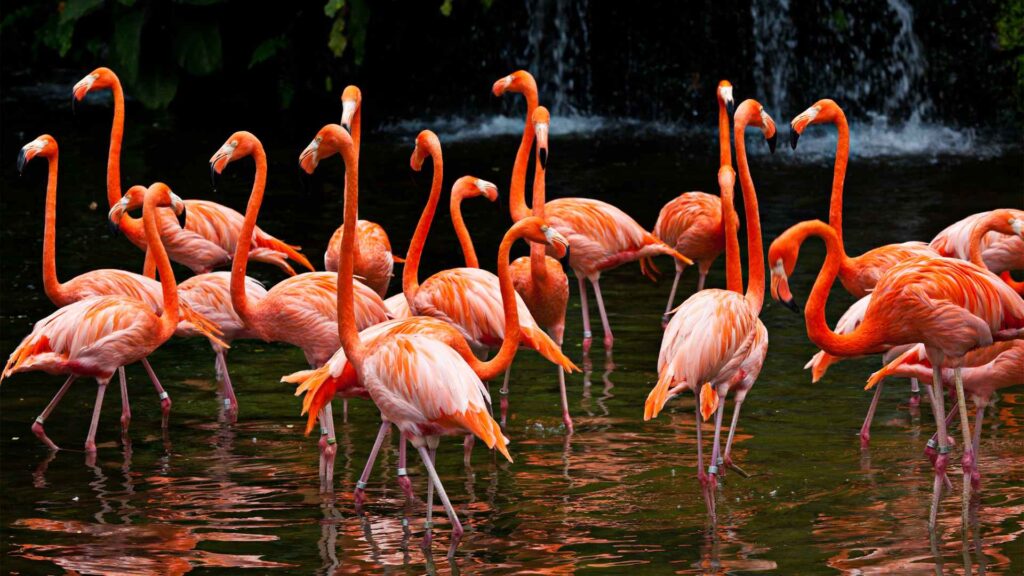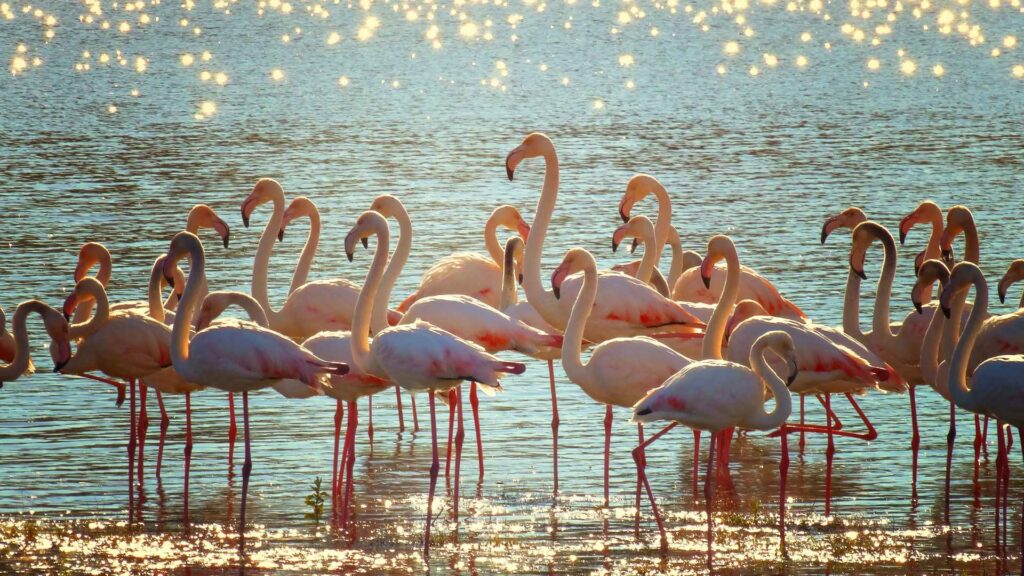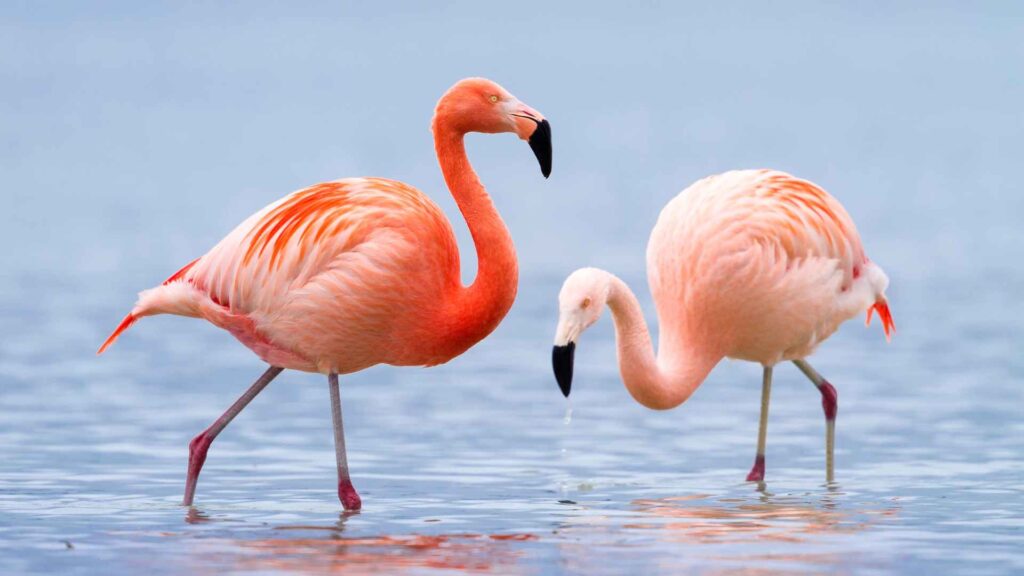Flamingos are among the most fascinating birds in the world, known for their vivid pink feathers and elegant posture. But there’s so much more to these vibrant creatures!
In this ultimate guide, we’ll explore over 145 fun facts about flamingos, grouped into captivating categories for an engaging read. Let’s dive in!
Flamingo Anatomy and Physiology
- Flamingos owe their pink color to carotenoid pigments found in their diet of algae, shrimp, and plankton.
- Their iconic long legs allow them to wade into deeper waters where other birds can’t feed.
- Flamingo knees are often mistaken for their ankles; their real knees are hidden under their feathers.
- They can sleep standing on one leg thanks to a unique locking mechanism in their joints.
- A flamingo’s beak is specially adapted to filter food from water.
- They have a unique filter-like structure in their mouths called lamellae, which helps sift through mud and water.
- Flamingos can turn their heads upside down to feed more efficiently.
- Their tongue is muscular and bristle-covered, perfect for pumping water in and out while feeding.
- They have excellent vision, even spotting food in muddy waters.
- Flamingos are surprisingly lightweight, despite their large size.
- Their wings are designed for long-distance flight, reaching speeds of up to 37 miles per hour.
- Flamingos have a specialized gland near their nostrils to excrete excess salt from their diet.
- Their feathers are waterproof, thanks to natural oils they spread during preening.
- Adult flamingos can grow up to five feet tall, but they only weigh about 4–8 pounds.
- Their bones are hollow, like those of most birds, aiding in flight and reducing weight.

Flamingo Behavior and Social Structure
- Flamingos are highly social birds, living in colonies that can number in the thousands.
- They communicate using a variety of honking and grunting sounds.
- Flamingos perform synchronized group dances during courtship.
- The iconic one-legged stance helps flamingos conserve body heat in cold water.
- They are known to form lifelong bonds with their mates.
- Parent flamingos take turns incubating their single egg.
- Flamingos are attentive parents, feeding their chicks a red, milk-like secretion from their upper digestive tract.
- Chicks are born with gray or white down feathers, developing their pink color over time.
- They establish pecking orders within their flocks, with dominant birds getting the best feeding spots.
- Flamingos often use their beaks to spar with one another during disputes.
- They build mud nests to keep their eggs safe from flooding and predators.
- Flamingos can travel hundreds of miles in search of food or suitable habitats.
- When startled, flamingos take off en masse in a stunning visual display.
- Flamingos spend a significant portion of their day preening to maintain their plumage.
- The vibrant color of their feathers plays a role in attracting potential mates.

Flamingo Habitat and Distribution
- Flamingos are found on every continent except Antarctica.
- They thrive in saline or alkaline lakes, lagoons, and estuaries.
- The Andes Mountains are home to several high-altitude flamingo species.
- Africa’s Rift Valley hosts vast populations of lesser flamingos.
- Some Caribbean islands are renowned for their pink flamingo flocks.
- Flamingos prefer shallow waters, where they can easily access food.
- The Greater Flamingo is the largest and most widespread species.
- Lesser Flamingos are the smallest and most numerous flamingo species.
- Flamingos are native to both the Old World (Africa, Europe, Asia) and the New World (Americas).
- They migrate seasonally, often over long distances, to find food and breeding grounds.
- Flamingos can survive in extreme environments, including volcanic lakes.
- The alkaline waters they inhabit are toxic to most other animals.
- Some flamingo species have adapted to temperatures as low as 5°F.
- They play an essential role in their ecosystems, helping to control algae and insect populations.
- Habitat loss and pollution pose significant threats to flamingo populations.
Flamingo Feeding and Diet
- Flamingos are filter feeders, relying on their unique beaks to sieve small organisms.
- Their diet includes algae, diatoms, small crustaceans, and brine shrimp.
- Flamingos stir up mud with their feet to expose hidden food sources.
- They feed with their heads upside down in shallow waters.
- Brine shrimp, rich in carotenoids, contribute to their vivid pink hue.
- Flamingos may travel miles daily in search of suitable feeding sites.
- They require shallow, open water to feed effectively.
- Algae blooms are a crucial food source for flamingos.
- Flamingos swallow small stones to aid in digestion, grinding up their food.
- They can consume large quantities of saltwater thanks to their salt-excreting glands.
- Juvenile flamingos feed on crop milk produced by their parents.
- Their feeding habits help maintain the ecological balance of their habitats.
- Flamingos can consume up to 20% of their body weight in food daily.
- They have a specialized tongue that functions like a pump during feeding.
- Their feeding process is essential for maintaining their brilliant feather coloration.
Cultural Significance of Flamingos
- Flamingos are symbols of beauty, grace, and elegance in many cultures.
- The ancient Egyptians revered flamingos, associating them with the sun god Ra.
- In Roman mythology, flamingo tongues were considered a delicacy.
- Flamingos feature prominently in Caribbean folklore and traditions.
- They are a popular motif in art, design, and fashion.
- The pink plastic lawn flamingo became an iconic American cultural symbol in the 1950s.
- Flamingos are often used in conservation campaigns to raise awareness for endangered species.
- They are a popular choice for zoos and aviaries worldwide due to their vibrant appearance.
- Flamingo dances have inspired choreographers and performers globally.
- The word “flamingo” is derived from the Spanish and Portuguese word “flamengo,” meaning flame-colored.
- Flamingos are featured on the coat of arms of the Bahamas.
- In astrology, flamingos represent balance, adaptability, and charisma.
- Flamingos appear in many brands’ logos as a symbol of uniqueness.
- Pink flamingos are a recurring theme in literature and movies as symbols of tropical paradise.
- In many cultures, spotting a flamingo is considered a sign of good fortune.

Bonus Facts About Flamingos
- Flamingos can live up to 40–50 years in the wild.
- They are monogamous and often stay with the same mate for years.
- Flamingos are born with straight beaks that curve as they mature.
- A group of flamingos is called a “flamboyance.”
- Flamingos can recognize individual members of their flock by their calls.
- They are most active during dawn and dusk.
- Flamingos often stand in windy areas to avoid mosquito bites.
- Their droppings can neutralize acidic soils in their habitats.
- Flamingos occasionally eat insects for extra protein.
- They can swim, though they rarely do.
- Flamingos are highly adaptable to changes in water levels.
- Male flamingos can be slightly larger than females.
- Some flamingos exhibit “mud-painting” behavior, spreading mud on their feathers for extra camouflage.
- Flamingos in captivity are often fed specially prepared diets to maintain their pink color.
- The oldest recorded flamingo lived to be 83 years old.
- Flamingos can drink boiling water from hot springs.
- They often roost together at night for safety.
- Flamingos have been seen riding thermal air currents during long flights.
- They play an essential role in attracting tourists to their natural habitats.
- Flamingos inspired the iconic filter in some smartphone apps.
- Flamingos are highly territorial when it comes to their nesting sites.
- The color intensity of their feathers can indicate their overall health and diet quality.
- Flamingos are more active on sunny days, displaying brighter colors in the light.
- They have been observed “dancing” in rainstorms, a behavior thought to be playful.
- Flamingos in captivity can sometimes lose their pink coloration if their diet lacks carotenoids.
- Wild flamingos are highly resilient to bacterial infections in their harsh habitats.
- They can spot predators from miles away due to their sharp eyesight.
- Flamingos communicate with chicks using unique vocalizations right after hatching.
- They use their curved beaks to collect water during nesting to keep eggs cool.
- In colder climates, flamingos are known to huddle together for warmth.
- Flamingos can tolerate highly toxic environments that other animals avoid.
- They sometimes adopt orphaned chicks in their flocks.
- Flamingos perform sunbathing behaviors, lying flat to absorb warmth.
- The greater flamingo can measure over 5 feet in wingspan.
- Flamingos can fly for up to 600 kilometers (373 miles) non-stop during migration.
- They are known to make mud balls as part of their feeding behavior.
- Flamingos occasionally steal nesting materials from their neighbors.
- Wild flamingo populations are closely monitored to prevent poaching.
- Their bones are rich in calcium, helping them withstand their harsh habitats.
- Flamingos are featured in ancient cave paintings and artwork.
- They produce a special oil to coat their feathers for insulation.
- Their migration patterns are often guided by the moon and stars.
- Flamingos rarely get sunburned despite spending hours in harsh sunlight.
- They use their feet to test the temperature of the water before wading.
- Flamingos are surprisingly agile during in-flight maneuvers.
- They have been observed drinking fresh water from rain pools during the rainy season.
- Flamingos occasionally play “tag” games with one another in their flocks.
- They avoid predators by nesting on islands inaccessible to most animals.
- Their pink color can fade slightly during the breeding season as they expend energy.
- Flamingos’ synchronized movements during courtship are unmatched in the bird kingdom.
Flamingos are extraordinary creatures, full of surprises and fascinating quirks.
Whether it’s their colorful feathers, unique feeding techniques, or cultural significance, flamingos continue to captivate and inspire people worldwide.
Their beauty and grace remind us of the wonders of nature and the importance of preserving these magnificent birds!
